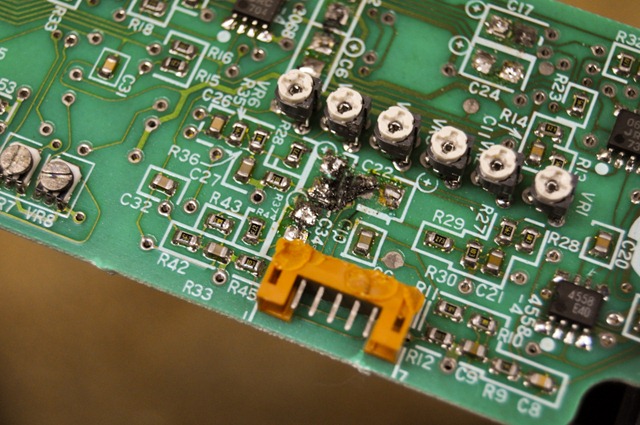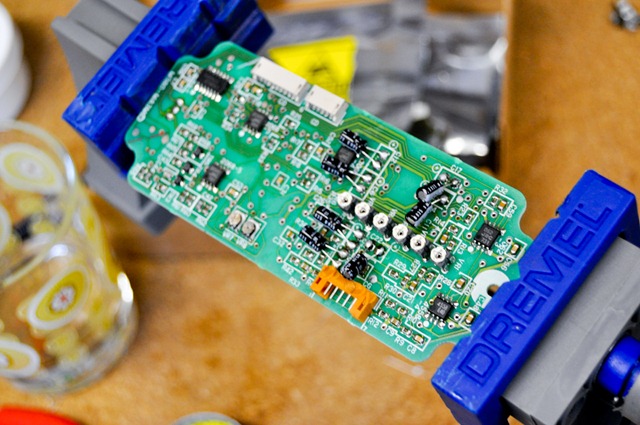Several months ago Jason asked me if I could fix a MIDI Guitar. I didn’t have the slightest idea how to fix one, and had only speculative knowledge about how they work, so naturally I said “yeah, sure, piece of cake”. If I’d have known at the time the kind of gear lust this project would create I might have turned him down at the outset.
The Casio PG-380 is a guitar that translates the notes you pick on the strings into MIDI Notes. Think of it like a Keytar, only its actually a guitar. You may think that the name brand somehow reduces the quality of this particular instrument, but you’d be mistaken; this baby is top of the line. It can translate amplitude, hammer-ons, and string bends with very little latency. I’d soon find out how hard to find, and how expensive, buying one of these would be.
The problem sounded simple: only the bottom two strings of the guitar were producing notes. At first I figured this must be a calibration issue or something, so I tweaked some of the pots on the board, messed with action height, etc in an effort to get the MIDI pick up to hear and translate the notes. This effort proved fruitless so I turned to the web.
How do you translate audio into midi? I had a vague idea how you could do this with envelope followers and some basic filter networks, but I wanted to understand how this thing actually worked before I could say with any certainty what was wrong with it. I looked around for a long time on the web and turned up nothing related to the technical aspects of converting the output of a guitar pickup to MIDI. In the end I relied on the premise that there must be a filter network to divide the audio by string, and a logic device to convert that analog value to a digital stream of bytes. Since 2 of the 6 strings were working, I could assume that the logic device was probably ok. I turned my attention to what I assumed was the filter network.
I cracked open the case and had a look around. I followed the traces from the pickup back to the 6 calibration pots to the series of capacitors that make up the filter network. I didn’t see anything visibly wrong so I returned to the internet to see if there were any already reported issues for the PG-380. Sure enough I came across [this post][2], which identified a common problem as deteriorating electrolytic capacitors in the filter network. It turns out that electrolytic capacitors go ‘stale’ if left unpowered for a long stretch of time. So, just replace the caps, right? Almost.

I’m usually pretty reckless (or overconfident), especially with my own gear, but when it’s someone else’s very expensive stuff on the line I tend to be a little more cautious. I prefer to stick with old PCBS, with large thru hole components. Think of your grandpa’s large print books. This was a modern board with tiny surface mount components, something I’ve never dealt with before. I searched around for some techniques I could use to get these little caps off the board and settled on the “hot tweezer” method. This is essentially taking a blow torch to a pair of tweezers until they’re hot enough to melt solder, then gripping the cap and pulling it off the board. This worked for the most part, though there were some persistent ones that I ended up just jamming a soldering iron under an pulling off. That “technique” ended up being a little messy; there is a plastic separator under the caps that melted all over the place. Those tweezers came in handy for scraping that crap off.

As for the replacement caps, I went with the smallest long lead electrolytic capacitors I could find. I had some of these lying around already and ordered the balance from Mouser. Along with some other stuff for future projects (and posts). Replacement was easy. Cut the leads short, flux the pads, tin the soldering iron, and tack one lead in place. After tacking one lead solder the other post, then fully solder the tacked post. Just like thru hole only you’re tacking the caps on top of the board. It looks a little goofy, but not as goofy as playing a keytar…
Capacitors in place I plugged the guitar in and went to work. Whoa. I hadn’t imagined using a guitar to trigger a synthesizer would be so fun.
I’m addicted and I have to give this thing back at some point. Looking around on the internet, these puppies go for upwards of $1500. So, if you have a less than perfect PG-380 for sale, perhaps one that needs some new capacitors, I’ll take it off your hands.